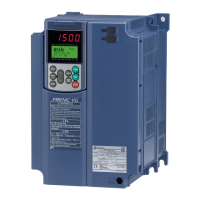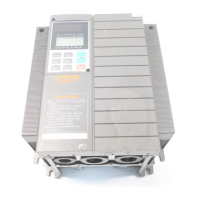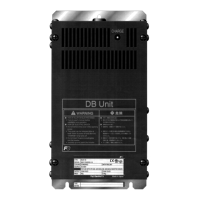12.3 Common Specifications
12-24
Item Explanation Remarks
Control
Hardware current
limiter
Limits the current by hardware to prevent an overcurrent trip from being caused by fast
load variation or momentary power failure, which cannot be covered by the software
current limiter. This limiter can be canceled.
Operation by
commercial power
supply
With commercial power selection commands (SW50, SW60), the inverter outputs
50/60 Hz.
Slip compensation
• Compensates for decrease in speed according to the load
• Possible to set constants for the response of slip compensation.
Droop control • Decreases the speed according to the load torque.
Torque limiter
Control output torque so that output torque is preset limiting value or less.
• Switchable between 1st and 2nd torque limit values
Torque current limiter
• Torque limit and Torque current limit are selectable. IMPG-VC
• Torque limit by analog input. PM-SVC
Software current
limiter
Automatically reduces the frequency so that the output current becomes lower than
the preset operation level. This limiter can be canceled.
Overload stop
If the detected torque or current exceeds the preset value, the inverter decelerates the
motor to a stop or causes the motor to coast to a stop.
PID control
• PID processor for process control/dancer control
• Normal operation/inverse operation
• PID command: Keypad, analog input (from terminals [12], [C1] (C1 function) and
[C1] (V2 function)), multistep frequency (3 steps), RS-485 communication
• PID feedback value: Analog input (from terminals [12], [C1] (C1 function) and
[C1] (V2 function))
• Alarm output (absolute value alarm, deviation alarm)
• Low liquid level stop function (pressurized operation possible before low liquid level
stop)
• Anti-reset wind-up function
• PID output limiter
• Integration reset/hold
Auto search for idling
motor speed
The inverter automatically searches for the idling motor speed and starts to drive it
without stopping it. Motor parameters require tuning. (Offline tuning)
Automatic
deceleration
• If the DC link bus voltage or calculated torque exceeds the automatic deceleration
level during deceleration, the inverter automatically prolongs the deceleration time
to avoid overvoltage trip.
(It is possible to select forcible deceleration actuated when the deceleration time
becomes three times longer.)
• If the calculated torque exceeds automatic deceleration level during constant
speed operation, the inverter avoids overvoltage trip by increasing the frequency.
Deceleration
characteristic
(improved braking
capacity)
The motor loss is increased during deceleration to reduce the regenerative energy in
the inverter to avoid overvoltage trip.
Auto energy saving
operation
Controls the output voltage to minimize the total sum of the motor loss and inverter
loss.
Overload prevention
control
If the surrounding temperature or IGBT junction temperature increases due to
overload, the inverter lowers the output frequency to avoid overload.
Battery/UPS operation
Cancels the undervoltage protection so that the inverter under an undervoltage
condition runs the motor with battery/UPS power.
Offline tuning
Tunes the motor while the motor is stopped or running, for setting up motor
parameters.
Online tuning
Controls the motor speed variation caused by the motor temperature rise during
running.
Cooling fan ON/OFF
control
• Detects inverter internal temperature and stops cooling fan when the temperature
is low.
• Possible to output a fan control signal to an external device.
1st to 2nd motor
settings
• Switchable between two motors
It is possible to set the base frequency, rated current, torque boost, and electronic
thermal slip compensation as the data for 1st and 2nd motors.

